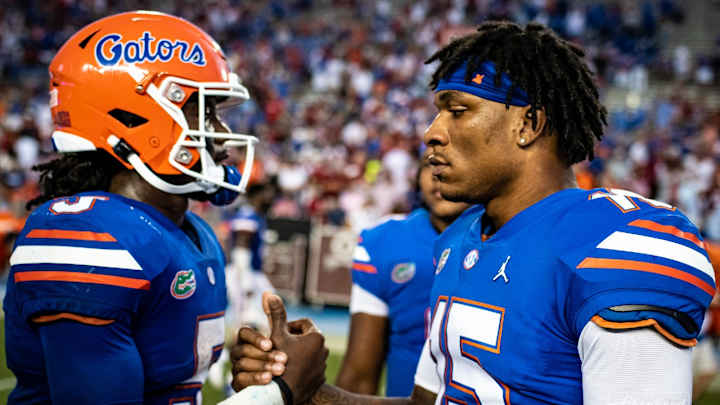Florida Gators 2021 Positional Review: Quarterback

Photo: Emory Jones and Anthony Richardson; Credit: Alex Shepherd
The 2022 national championship has come and gone, writing a storybook ending to the 2021 college football season as Georgia, led by former walk-on quarterback Stetson Bennett IV, raised the trophy for the first time in 41 years.
Before we move onto what will surely be an exciting offseason in Gainesville, it's time to reflect on the Florida Gators' 2021 season, taking a look at what went right and what went wrong for UF with a position-by-position analysis of the team.
Naturally, we'll start with the quarterbacks.
After three long years of hype for former UF head coach Dan Mullen's first quarterback signee, redshirt junior Emory Jones took over as Florida's starting signal-caller in 2021 in place of former Heisman Trophy finalist Kyle Trask.
There had long been a narrative that Mullen had yet to play a quarterback that truly fit his offensive system at Florida after he inherited Trask and Feliepe Franks from the previous coaching staff, which made Gator fans giddy to see Jones in action in a full-time role. He had flashed plenty of talent over his career in a rotational setting and was consistently praised by Mullen, the staff, his teammates and previous starting QBs.
However, Jones did not exactly live up to the billing that had been established over three seasons.
As seen throughout the first 75 percent of his Gators career, Jones brought a lot of life to Florida's formerly middling rushing attack, leading the team in rushing yardage on the season with 758 yards to go with four touchdowns on the ground. Possessing a "cannon of an arm," as Mullen often put it, Jones made some impressive throws during the season and specifically seemed to succeed on play-action concepts.
But, as a pure dropback passer, Jones' limitations were exposed in 2021. He struggled at times with anticipating throwing windows and trusting his reads, which resulted in 13 interceptions on the season and an interception rate of 3.8 percent. Trask's career interception percentage, comparatively, was 1.8 percent.
Jones finished his first season as starter having completed 64.6 percent of his passes for 2,733 yards and 19 touchdowns.
Although it was understood that Jones isn't as poised of a decision-maker as Trask and other top college quarterbacks, there were times when Mullen's gameplan for Jones came into question. Jones had a higher completion percentage, increase his yards per catch and average depth of target substantially, and cut his interception rate nearly in half on play-action concepts compared to standard dropbacks.
Yet, Mullen and late-season interim offensive coordinator Garrick McGee called play-action on only 39.9 percent of Jones' passing snaps. Almost halfway through the season, after five games, Jones' play-action usage was at 33.1 percent. Ole Miss QB Matt Corral, one of the nation's best passers, for example, ran play-action on 61.8 percent of plays at that time and finished the season at 60.4 percent.
In hindsight, it is fair to wonder if Mullen and his coaching staff didn't set Jones up for maximum success within their gameplan. But alas, Jones, who currently remains with the team despite telling Yahoo! Sports in Dec. 2021 that he planned to enter the transfer portal, enters an offseason after a disappointing campaign with the starting role no longer firmly in his grip.
While Jones struggled with consistency throughout the year, another quarterback began to rise to orange and blue fame: Redshirt freshman Anthony Richardson.
Richardson's availability was not fantastic throughout the year while he nursed hamstring, concussion, and knee injuries, the third injury requiring postseason surgery. But, when he was on the field, Richardson had a tendency to make jaws drop, showing off incredible speed for a big-bodied quarterback and a massive arm to push the ball down field.
The game may have ended in a loss, but Richardson is the reason behind Florida's 15-point comeback against LSU in October, as he led the Gators' offense to four consecutive touchdowns in the second half, each of which he played a part in (three passing, one rushing). The game was tied late in the fourth quarter up until a go-ahead Tigers' touchdown from UF's one-yard line.
Richardson would earn the starting role against Georgia as a result but the results were not pretty. Richardson committed three first-half turnovers and left the game in the third quarter with an injury. Jones regained the gig at that point and didn't look back for the rest of the year.
Richardson finished his season having completed 59.4 percent of his passes for 529 yards, six touchdowns and five interceptions, rushing for 401 yards and three scores as well.
Now, with a new head coach in town in Billy Napier and Jones' future with the team in question, it remains to be seen who will start at quarterback in 2022 and what the depth chart in general will look like. We'll dive into that in February after national signing day when we begin the AllGators positional outlook series.
Stay tuned to AllGators for continuous coverage of Florida Gators football, basketball and recruiting. Follow along on social media at @SI_AllGators on Twitter and Florida Gators on Sports Illustrated on Facebook.

Zach Goodall is the publisher of AllGators.com on FanNation-Sports Illustrated, serving as a beat reporter covering football, recruiting, and occasionally other sports since 2019. Before moving to Gainesville, Zach spent four years covering the Jacksonville Jaguars for SB Nation (2015-18) and Locked On Podcast Network (2017-19), originally launching his sports journalism career as a junior in high school. He also covered the Tampa Bay Buccaneers for FanNation-Sports Illustrated (2020-22). In addition to writing and reporting, Zach is a sports photographer and videographer who primarily shoots football and basketball games, practices and related events. When time permits in the 24/7 media realm, Zach enjoys road trips, concerts, golf and microbreweries.
Follow zach_goodall